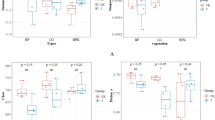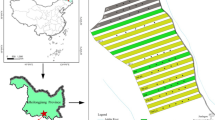Abstract
Large-scale afforestation programs have had some beneficial effects on reducing severity of dust storms and controlling desertification in arid and semi-arid regions. However, the influences of selective afforestation on soil arthropod community are largely unknown in desertified ecosystems. Soil macrofaunal communities, soil physico-chemical properties, and herb vegetation were investigated in afforested shrublands and woodlands (both approximately 30 years old post-afforestation), which were compared to shifting sand lands in Horqin, northern China. In the shrublands, environmental parameters (soil and vegetation properties) indicated a significant improvement of soil organic carbon, total nitrogen, and herbaceous density and cover, in comparison to the woodlands and shifting sand lands. The improved shrubland habitat maintained significantly higher soil macrofaunal abundance and group richness together with higher diversity compared with the woodlands and shifting sand lands. There were no significant differences in soil macrofaunal diversity between the woodlands and shifting sand lands. The results suggest that shrubs can facilitate macrofaunal assemblies and improve soil and vegetation properties when planted in shifting sand lands. Shrub afforestation is beneficial for the restoration of shifting sand lands, and is recommended for management of artificial plantations in these sandy ecosystems.



Similar content being viewed by others
References
Andersen AN, Hoffmann BD, Müller WJ, Griffiths AD (2002) Using ants as bioindicators in land management: simplifying assessment of ant community responses. J Appl Ecol 39:8–17
Ayal Y (2007) Trophic structure and the role of predation in shaping hot desert communities. J Arid Environ 68:171–187
Blaum N, Seymour C, Rossmanith E, Schwager M, Jeltsch F (2009) Changes in arthropod diversity along a land use driven gradient of shrub cover in savanna rangelands: identification of suitable indicator. Biodivers Conserv 18:1187–1199
Chen BH, Hao YG, Chen YF (2003) Research on climate ecological effect evaluation of regional protection forest system in Wulanbuhe Desert. For Res 16:63–68
Doblas-Miranda E, Sánchez-Piñero F, González-Megías A (2009) Different microhabitats affect soil macroinvertebrate assemblages in a Mediterranean arid ecosystem. Appl Soil Ecol 41:329–335
Guan HB, Guo L, Liu YJ (1999) The vertical distribution, seasonal dynamics and community diversity of soil animal in Horqin sandy land. J Desert Res 19 s:110–114
Jiang DM, Li Q, Liu FM, Jiang Y, Liang WJ (2007) Vertical distribution of soil nematodes in an age sequence of Caragana microphylla plantations in the Horqin Sandy Land, Northeast China. Ecol Res 22:49–56
Kennedy N, Brodie E, Connolly J, Clipson N (2004) Impact of lime, nitrogen and plant species on bacterial community structure in grassland microcosms. Environ Microbiol 6:1070–1080
Li FR, Zhao LY, Zhang H, Zhang TH, Shirato Y (2004) Wind erosion and airborne dust deposition in farmland during spring in Horqin sand land of eastern Inner Mongolia, China. Soil Till Res 75:121–130
Liu RT, Zhao HL, Zhao XY, Drake S (2009) Soil macrofaunal response to sand dune conversion from mobile dune to fixed dune in Horqin sand land, Northern China. Eur J Soil Biol 45:417–422
Liu RT, Zhao HL, Zhao XY, Drake S (2011) Facilitative effects of shrubs in shifting sand on soil macro-faunal community in Horqin sand land of Inner Mongolia, Northern China. Eur J Soil Biol 47:316–321
Lobry de Bruyn LA (1999) Ants as bioindicators of soil function in rural environments. Agric Ecosyst Environ 74:425–441
Noemí Mazía C, Chaneton EJ, Kitzberger T (2006) Small-scale habitat use and assemblage structure of ground-dwelling beetles in a Patagonian shrub steppe. J Arid Environ 67:177–194
Pen-Mouratov S, Rodriguez-Zaragoza S, Steinberger Y (2008) The effect of Cercidium praecox and Prosopis laevigata on vertical distribution of soil free-living nematode communities in the Tehuacán Desert, Mexico. Eco Res 23:973–982
Pérez FL (1992) The influence of organic matter addition by caulescent Andean rosettes on surficial soil properties. Geoderma 54:151–171
Salamon JA, Zaitsev A, Gärtner S, Wolters V (2008) Soil macrofaunal response to forest conversion from pure coniferous stands into semi-natural montane forests. Appl Soil Ecol 40:491–498
Saul-Tcherkas V, Steinberger Y (2009) Temporal and shrub adaptation effect on soil microbial functional diversity in a desert system. Eur J Soil Sci 60:871–882
Schon NL, Mackay AD, Minor MA, Yeates GW, Hedley MJ (2008) Soil fauna in grazed New Zealand hill country pastures at two management intensities. Appl Soil Ecol 40:218–228
Seeber J, Seeber GUH, Langel R, Scheu S, Meyer E (2008) The effect of macro-invertebrates and plant litter of different quality on the release of N from litter to plant on alpine pastureland. Biol Fertil Soils 44:783–790
Seeber J, Langel R, Meyer E, Traugott M (2009) Dwarf shrub litter as a food source for macro-decomposers in alpine pastureland. Appl Soil Ecol 41:178–184
Stockton PH, Gillette DA (1990) Field measurement of the sheltering effect of vegetation on erodible land surface. Land Degrad Rehabil 2:77–85
Su YZ, Zhao HL (2003) Soil properties and plant species in an age sequence of Caragana microphylla plantations in the Horqin Sandy Land, North China. Ecol Eng 20:223–235
Takeda H, Abe T (2001) Templates of food–habitat resources for the organization of soil animals in temperate and tropical forests. Ecol Res 16:961–973
Ter Braak CJF, Šmilauer P (1998) Canoco 4-reference manual and user’s guide to Canoco for Windows: software for canonical community ordination, version 4. Microcomputer Power, Ithaca
Thomas F, Folgarait P, Lavelle P, Rossi JP (2004) Soil macrofaunal communities along an abandoned rice field chronosequence in Northern Argentina. Appl Soil Ecol 27:23–29
Wang XM, Zhang CX, Hasi E, Dong ZB (2010) Has the Three-North Forest Shelterbelt Program solved the desertification and dust storm problems in arid and semi-arid China? J Arid Environ 74:13–22
Wardle DA, Bardgett RD, Klironomos JN, Setälä H, van der Putten WH, Wall DH (2004) Ecological linkages between aboveground and belowground biota. Science 304:1629–1633
Whitford WG (2000) Keystone arthropods as webmasters in desert ecosystems. In: Coleman DC, Hendrix PF (eds) Invertebrates as webmasters in ecosystems. CABI Publishing, London, pp 25–42
Yin WY (2001) Pictorial keys to soil animals of China. Science Press, Beijing
Zhao ZW, Li SQ, Zhang BQ, Gan TL (1999) Effects of “Three North” protective forest engineering in Gansu and strategies for sustainable development. J Desert Res 19:191–194
Zhao HL, Zhao XY, Zhou RL, Zhang TH, Drake S (2005) Desertification processes due to heavy grazing in sandy rangeland, Inner Mongolia. J Arid Environ 62:309–319
Zhao HL, Cui JY, Zhou RL, Zhang TH, Zhao XY, Drake S (2007a) Soil properties, crop productivity and irrigation effects on five croplands of Inner Mongolia. Soil Till Res 93:346–355
Zhao HL, Zhou RL, Su YZ, Zhang TH, Zhao LY, Drake S (2007b) Shrub facilitation of desert land restoration in the Horqin sand land of Inner Mongolia. Ecol Eng 31:1–8
Zhao XY, Luo YY, Wang SK, Huang WD, Lian J (2010) Is desertification reversion sustainable in northern China? A case study in Naiman county, part of a typical agro-pastoral transitional zone in Inner-Mongolia, China. Global Environ Res 14:63–70
Acknowledgments
The authors are grateful to the anonymous reviewers for their critical review and comments on drafts of this manuscript. This study was financially supported by National Natural Science Foundation of China (No. 41101050), projects of the National Basic Research Program of China (No. 2009CB421303) and National Science and Technology Support Program (2011BAC07B03). We would like to thank Christine Verhille at the University of British Columbia for her assistance with English language and grammatical editing of the manuscript. We also thank Doc. Yuqiang Li (School of Natural Resources, University of Nebraska-Lincoln, USA) for the English corrections.
Author information
Authors and Affiliations
Corresponding author
About this article
Cite this article
Liu, R.T., Zhao, H.L. & Zhao, X.Y. Changes in soil macrofaunal community composition under selective afforestation in shifting sand lands in Horqin of Inner Mongolia, northern China. Ecol Res 28, 1–8 (2013). https://doi.org/10.1007/s11284-012-0982-0
Received:
Accepted:
Published:
Issue Date:
DOI: https://doi.org/10.1007/s11284-012-0982-0




